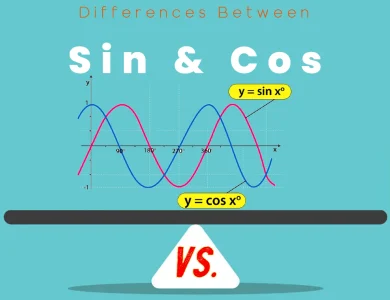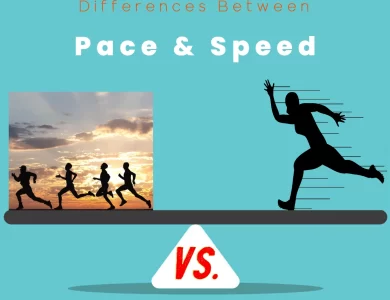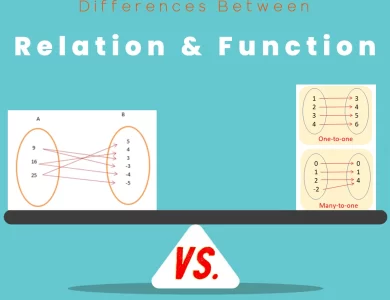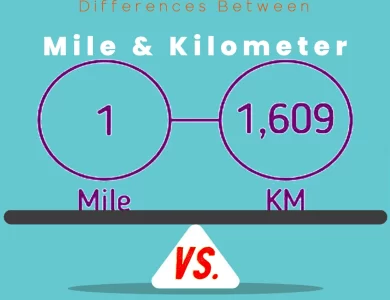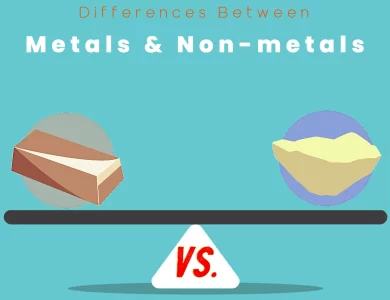Mathematics
Whether you’re a student, educator, or simply someone with a curious mind, this collection of content will provide you with valuable insights into the various distinctions that exist within the vast field of Mathematics.
Mathematics is a rich discipline encompassing a multitude of concepts, theories, and techniques. One fascinating aspect of this subject is the existence of differences in terms and other items. These differences might seem subtle at first glance, but they can have a profound impact on how we understand and apply mathematical principles. Through this category, we aim to shed light on these disparities and enhance your mathematical knowledge.
-

Differences Between Sin and Cos
Embarking on a journey through the realm of trigonometry, the distinctions between sine (sin) and cosine (cos) functions come to light. Beyond their fundamental definitions—sin(θ) representing the ratio of opposite to hypotenuse and cos(θ) signifying adjacent to hypotenuse—lies a rich tapestry of contrasts. Graphically, the sine function unfolds as an oscillatory wave, initiating at zero, reaching peaks, descending to troughs, and perpetually repeating. Conversely, the cosine function, while sharing similarities, exhibits a phase shift, starting at its peak and following a cyclical pattern. These nuances extend to real-world applications; sine finds resonance in harmonic motion and AC circuits, while cosine excels in scenarios with phase shifts, prevalent in physics and control systems. The symmetrical disparities, odd nature of sine, and even characteristics of cosine, reverberate through trigonometric identities and mathematical manipulations. Integrating and differentiating these functions brings forth sign alternations, adding another layer to their intricate relationship. As we navigate their shared frequency, periodicity, and delve into Euler's formula, a profound connection emerges, expressing these functions in the language of complex analysis. Unveiling the differences between sine and cosine functions not only enriches our understanding of trigonometry but also illuminates their pivotal roles in diverse mathematical landscapes and real-world scenarios.
-

Speed vs Pace
In the realm of athletic pursuits, the contrast between pace and speed is more than meets the eye. Like two sides of a coin, these terms often intertwine, yet their roles are uniquely defined. Pace strides in as the consistent heartbeat of endurance, measuring the time taken per unit of distance covered. It's your steady companion during marathons, ensuring you don't burn out too soon, maintaining a rhythm that leads you triumphantly to the finish line. Think of it as the compass guiding your journey through long stretches. Speed, on the other hand, takes the spotlight when urgency and rapidity are at play. It's not concerned with distance; rather, it's all about the rate of motion, the swift propulsion that sends you hurtling toward victory in a sprint. Whether it's a 100-meter dash or a quick burst of acceleration in sports like tennis or basketball, speed is your ally in the pursuit of lightning-fast accomplishments. To measure pace, think "minutes per mile" or "minutes per kilometer." It's the art of maintaining a steady rhythm over a prolonged journey. Speed, on the other hand, revels in metrics like "miles per hour" or "meters per second," slicing through the essence of time itself, emphasizing the sheer rapidity of motion. So, next time you're pounding the pavement or sprinting on the track, remember that pace and speed, though harmonious, dance to different tunes. They're the yin and yang of your athletic endeavors, offering diverse ways to conquer challenges, set records, and embrace the full spectrum of motion.
-

Function vs Relation
Delving into the intricate world of mathematics, it becomes evident that relations and functions stand as cornerstones of numerical analysis. While their surface might hint at similarities, a deeper examination reveals stark differences that define their roles in mathematical contexts. Relations act as bridges connecting elements from distinct sets through ordered pairs. Akin to social connections, they display the interplay between variables without enforcing a strict one-to-one mapping. From graphs to tables, relations come alive through various representations, capturing the multifaceted nature of connections. Functions, on the other hand, introduce a layer of predictability. These specialized relations establish a one-to-one connection, where each input corresponds to a unique output. Often portrayed through equations or mappings, functions guide calculations and predictions, transforming abstract ideas into practical applications. In real-world scenarios, relations mirror social networks, representing diverse connections among entities. In contrast, functions assume roles as predictive tools, estimating outcomes based on given inputs. Their distinct attributes have far-reaching implications, shaping the way we model relationships and forecast results in fields ranging from physics to economics. The journey through relations and functions uncovers the beauty of mathematical diversity. Just as the intricacies of relations weave a complex web of connections, the structured elegance of functions provides a roadmap for predicting and understanding the world around us. As we embrace these differences, we enrich our mathematical toolkit, equipping ourselves to tackle a wide array of challenges with precision and insight.
-

Non Parametric vs Parametric
Delving into the world of statistical analysis, one encounters the pivotal choice between parametric and non-parametric methods. These two methodologies anchor diverse statistical explorations, each boasting distinct strengths and limitations. Parametric methods, resembling precision instruments, make assumptions about the data's distribution. They thrive when data adheres to the assumed distribution, yielding accurate results. However, these methods stumble when data strays from the expected path, making assumptions a potential Achilles' heel. They demand larger sample sizes for robust outcomes and can be sensitive to outliers. Non-parametric methods, on the other hand, showcase flexibility akin to chameleons. They operate without specific distribution assumptions, making them versatile in varied data scenarios. They excel in situations where data distribution remains an enigma, when assumptions crumble, or when small sample sizes are at play. Their robustness against outliers offers a safety net in turbulent data landscapes. While parametric methods excel in cases where assumptions are valid, non-parametric methods offer a haven for situations shrouded in uncertainty. The choice between these methodologies hinges on data characteristics, research goals, and the balance between accuracy and flexibility. As technology evolves, hybrid approaches may bridge the gap, leveraging both paradigms to harness the power of precision and adaptability. Armed with this understanding, statisticians navigate the analytical cosmos with confidence, ensuring the chosen method aligns seamlessly with data realities and research objectives.
-

Kilometer (km) vs Mile
Embark on a journey to understand the nuanced disparities between miles and kilometers (km), the twin pillars of distance measurement. Beyond their numerical values, these units encapsulate histories, cultures, and practical applications that influence how we perceive the world around us. While miles evoke echoes of ancient Roman footsteps, the kilometer thrives as a symbol of modern global unity. The mile, stemming from the Imperial and United States customary systems, finds its place on road signs, athletic tracks, and even in the tapestry of idiomatic expressions. In contrast, the kilometer emerges from the metric system's pursuit of coherence, offering a decimal progression that resonates across scientific research, international trade, and daily life. Whether you're navigating roads or running marathons, comprehending the differences between these units offers insights into the diverse landscapes of measurement. Join us as we dive into the semantic distinctions, historical significance, and practical implications that set the mile and kilometer apart – a voyage that unravels the stories of measurement and the human quest to quantify the world.
-

Non-Metals vs Metals
Welcome to a captivating journey through the captivating realms of metals and non-metals. In this blog, we'll uncover the secrets behind these elemental entities and explore their unique properties, applications, and significance in our everyday lives. From the shiny brilliance of metals to the versatile characteristics of non-metals, we'll delve into their distinct attributes that shape our physical world. Metals, with their characteristic metallic luster, exceptional strength, and conductivity, find applications in construction, transportation, electronics, and jewelry. Meanwhile, non-metals, which lack the metallic luster, exhibit diverse properties and play vital roles in healthcare, energy production, agriculture, and beyond. We'll delve into their contrasting physical and chemical properties, from malleability and ductility to their reactivity and bonding characteristics. Join us on this captivating adventure as we explore the interplay between metals and non-metals, their impact on our environment, and the importance of sustainable practices. We'll unravel the mysteries behind their extraction, production, and disposal, while highlighting the efforts being made to minimize their environmental footprint. By the end of this blog, you'll gain a deeper understanding of how metals and non-metals shape our world and the steps we can take to foster a more sustainable future. So, get ready to embark on a journey through the wonders of metals and non-metals, where shimmering brilliance and versatile properties await. Let's delve into the captivating world of elements and expand our knowledge of these fundamental components that surround us.
-

River vs Creek
Welcome to the fascinating world of rivers and creeks, where nature's flowing water brings beauty, serenity, and adventure. In this captivating exploration, we'll dive deep into the differences and similarities between these two enchanting water bodies. Rivers, with their grandeur and vastness, carve their way through landscapes, spanning great distances and serving as lifelines for entire regions. On the other hand, creeks, with their smaller scale and intimate charm, meander through forests and meadows, creating picturesque scenes of tranquility. While rivers and creeks may differ in size, flow, and surrounding landscapes, they both play vital roles in ecosystems and offer a myriad of recreational opportunities. Rivers, with their continuous and steady flow, provide sustenance to diverse habitats, support trade and commerce, and serve as important water sources for communities. Creeks, on a smaller scale, offer intimate settings for peaceful walks, wildlife habitats, and a source of inspiration for artists and photographers. Join us on this captivating journey as we unravel the secrets that rivers and creeks hold. Explore their ecological importance, learn about their cultural significance, and discover the ways in which they shape the land and our interactions with it. Whether you find yourself in awe of a mighty river or enchanted by the gentle flow of a creek, you'll come away with a deeper appreciation for these mesmerizing water bodies. So, grab your virtual paddle and let's set sail on this adventure of exploration and discovery!
